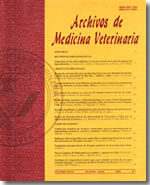Parasitological findings of lesser rhea, Pterocnemia pennata (D´orbigy) in faeces from northern patagonian, Argentina
Main Article Content
Abstract
There have been scanty studies to determine what parasites are present in lesser rhea farms from Argentina. The aim of this study was to determine the prevalence of parasitic diseases in lesser rhea farms. Ten lesser rhea (Pterocnemia pennata) farms located in Northern Patagonia, Argentina, were visited over a 1-year period. A total of 310 fresh faecal samples from chicks, juvenile and adult lesser rhea were collected and processed by Willis and McMaster techniques. Out of 310 faecal samples examined, Eimeria spp oocysts were found in 31.3%, Capillaria sp in 1.9% and Trichostrongylus sp in 8.7%. A low number of nematode eggs and oocysts were found in most faecal samples. Infection by Capillaria sp (Nematoda) was found in 32% of the birds in one farm. According to our results, parasitic diseases in lesser rhea farms do not seem to constitute a serious problem under Argentinean production conditions. This paper reports for the first time the level of parasitism in lesser rhea farms in Argentina.

